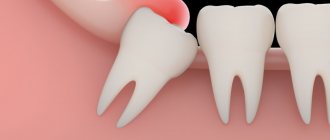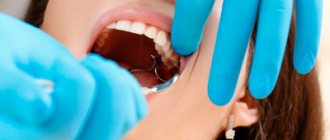Surface formations on teeth
On the surface of the tooth there is a cuticle, pellicle, as well as plaque and tartar (with poor oral hygiene).
The cuticle, or reduced epithelium of the enamel organ, is lost soon after eruption, and therefore does not play a significant role in the physiology of the tooth. This formation, found mainly in the subsurface layer of enamel, sometimes comes to the surface in the form of a microscopic film.
In some places, the cuticle in the form of a tube reaches the enamel-dentin junction.
Pellicle (acquired cuticle) is formed from salivary glycoproteins on the surface of the tooth after its eruption. If the tooth comes into contact with saliva, then when the pellicle is removed with an abrasive, it is quickly restored. The pellicle is a structureless formation, tightly fixed on the surface of the tooth, and plays an important role in the selective attachment of bacteria.
The processes of diffusion and permeability in the surface layer of enamel depend on the state of the pellicle. To a certain extent, this shell protects the integrity of the enamel structure, but a large number of pellicles is not an indicator of enamel resistance.
Above the pellicle you can find dental plaque - a dense formation consisting of bacteria located inside a matrix, which is formed by proteins, polysaccharides, lipids and some inorganic substances (calcium, phosphates, magnesium, potassium, sodium, etc.)
Plaque is attached to the tooth surface less tightly than pellicle, and at the same time, unlike food debris, it cannot be removed by simple rinsing. Plaque begins to accumulate soon after brushing your teeth; it is formed by the adsorption of microorganisms on the surface of the enamel and grows due to the constant layering of new bacteria, and in a certain sequence: first, coccal flora, and then rod-shaped and filamentous bacteria. As plaque grows and its thickness increases, anaerobic forms of bacteria begin to predominate.
Plaque has a porous structure, which allows carbohydrates to freely penetrate into its deep layers. When eating soft foods and consuming a significant amount of easily fermentable carbohydrates, its significant and rapid growth occurs.
Most often, dental plaque is located above the gum, in the cervical region, in fissures, and more microorganisms accumulate at the entrance to the fissures than in the depths.
80-85% of dental plaque consists of water. As for mineral components, calcium, general and inorganic phosphates, and fluorides predominate. Calcium in plaque may be associated with bacteria, extracellular proteins, or phosphates, which in turn may exist as inorganic orthophosphate or organic compounds. Fluoride is present in low concentrations in plaque fluid and in high concentrations in solid plaque. Although the mechanism of fluoride binding in plaque has not been fully elucidated, there are suggestions that the ion accumulates inside bacteria and forms extracellular complexes with calcium. The aqueous phase (plaque fluid), constituting 25-35% of the total volume, is located extracellularly and is an “incubation medium” for bacteria.
Plaque can be white, green or brown.
Soft white plaque, visible without staining with special solutions, accumulates mainly during the period of rest of the speech and chewing apparatus and in the absence of proper oral hygiene. This type of plaque can cause bad breath, distort the sense of taste, and also serve as a center of mineralization during the formation of tartar.
Green plaque, more often observed in children and young patients, is located in a thin layer on the labial surfaces, mainly of the front teeth. The appearance of this plaque is associated with the vital activity of chromogenic microorganisms containing chlorophyll.
Brown plaque is more common in smokers, and its color depends on the nicotine and intensity of smoking. It is difficult to clean with toothbrushes and toothpastes, but dental plaque can be white, green and brown. To remove it, teeth should be treated with hard brushes and special fine pastes.
Brown plaque can also occur in non-smokers due to a large number of copper amalgam fillings, as well as in people who work on the manufacture of copper, brass and bronze products. In children, plaque of this color often forms on baby teeth when a large amount of unreduced iron is secreted with saliva, which, combining in the oral cavity with sulfur from decaying protein substances, causes staining.
Calcification of dental plaque leads to the formation of tartar, hard deposits of varying consistency and color. Calcium phosphate crystals that are deposited within plaque may be closely associated with the enamel surface. Sometimes, especially in the presence of demineralization, it is difficult to determine where the enamel ends and the stone begins. For the formation of supragingival calculus, minerals coming from saliva are used mainly, while subgingival calculus is used from gingival fluid. The organic part of the stone is a protein-polysaccharide complex, including epithelial cells, leukocytes, microorganisms, and food debris.
Stone deposition, sometimes of considerable thickness, occurs in both the subgingival and supragingival areas. Calcification begins in plaque, which is present on the teeth for at least a few days.
Supragingival tartar is most often localized in the area of the lower frontal teeth and the buccal surfaces of the upper molars, where the ducts of the salivary glands open. In the absence of hygienic care, stone formation occurs on teeth that are not involved in the act of chewing. The color of the stone (white, yellow, brown) depends on the effects of food, nicotine, as well as oxides of iron, copper and other substances.
Subgingival tartar is revealed only by probing. It is usually dark brown in color with a greenish tint, and is formed on the neck of the tooth within the gingival groove, on the root cement, in the periodontal pocket. The stone surrounds the neck of the tooth, often forming projections, and is firmly attached to the underlying surface.
If a patient develops a significant amount of tartar, this may be due to a decrease in the concentration of pyrophosphate, a tartar inhibitor, or the absence of a specific salivary protein that prevents calcium phosphate precipitation and crystal growth.
Nature of formations
All surface formations on teeth are divided into physiological, determined by their structure, and pathological.
The latter are formed due to bacteria accumulating in the oral cavity, as well as food debris. This is the result of improper oral care and neglect of preventive measures to improve dental health.
Pathological deposits are of particular interest, since physiological deposits, in most cases, do not provoke dental diseases.
Such deposits develop gradually: first they take the form of a soft coating, and then, as the crystals grow, they turn into hardened masses and stones.
Physiological and pathological formations
Surface films of a physiological nature include the cuticle and pellicle.
Pathological deposits are dental plaque, tartar, plaque of various types.
Formations of a pathological nature are formed due to:
- poor oral care;
- the predominance of too soft foods in the diet;
- malocclusion;
- inflammatory diseases of the oral cavity;
- damage to the enamel structure.
Since the enamel, even under normal conditions, has a rough structure and is covered with microscopic cracks, external factors contribute to its uneven expansion. This creates conditions for the accumulation of minerals on the teeth, which over time form a dense structure.
Such deposits provoke the destruction of enamel, gum disease, caries, and bad breath. In addition, because of them, teeth do not look aesthetically pleasing.
Oral care after professional teeth cleaning
During the first 24 hours after professional teeth cleaning, patients are not recommended to eat foods with pronounced coloring components. It is advisable to give up strong coffee, tea and smoking. Also, during the appointment, the dentist must apply special products to prevent the formation of deposits and strengthen the enamel.
After eating, you need to brush your teeth or at least rinse your mouth with water, eat an apple or chew gum. Today there are a large number of toothpastes that actively prevent the formation of any deposits. It is advisable to have them recommended to you by your dentist.
All this will help not only avoid the formation of tartar, but also prevent many diseases of the periodontium and hard dental tissues.
Classification of sediments and their composition
In modern dentistry, they use the classification developed by G. N. Pakhomov; he identified 2 main types: non-mineralized dental plaque and mineralized dental plaque. The basis for this classification of plaque was the mineral substances included in their chemical composition. In addition, sediments include organic substances and microorganisms.
Non-mineralized
Pellicle
The pellicle is called the acquired cuticle. It is formed throughout life, in contrast to the Nasmit shell, which disappears as soon as teeth erupt. It is a very thin, transparent organic film with a high concentration of proteins, formed from the viscous components of saliva. The dental pellicle is divided into three layers:
- superficial,
- surface,
- subsurface.
The multilayer structure gives the pellicle the properties of a semi-permeable membrane. It retains fluorides in the enamel. On one side, the tooth pellicle protects hard tissues, on the other, bacteria and microorganisms attach to it, forming plaque. Removing the pellicle is pointless, because it forms again (20-30 minutes). When coloring pellicles with food dyes, the film is removed with abrasives.
Plaque
Pathogenic microorganisms and the substances they produce become tightly attached to the surface of one or more teeth, creating an acidic environment that leads to the destruction of enamel. This phenomenon is called dental plaque. They often form in areas of the oral cavity that are difficult to access for high-quality cleaning: fissures and grooves, chewing surfaces, cervical areas.
Manual professional teeth cleaning
With an integrated approach to teeth cleaning, the manual method is used last by dentists. With it you can:
- Smooth out roughness caused by plaque;
- Eliminate plaque and tartar residues in difficult-to-treat areas of the oral cavity;
- Remove surface pigmentation from food dyes on enamel;
- Treat interdental spaces;
- Stop the development of pathology in the periodontium.
Manual teeth cleaning is the final stage of the entire procedure and is carried out using various instruments. The most popular are strips - special strips with a rough coating. Using strips, the dentist eliminates all errors caused by hardware in the interdental spaces. Floss or dental floss is used in the same way.
Brushes with polishing pastes are quite popular, effectively removing even very old plaque and stones. For a more powerful impact, instruments such as curettes are used. They are produced to work in a wide variety of groups of teeth. They have a very sharp working surface, so if used correctly they can remove all deposits as effectively as possible.










